Americans would be better off keeping their payroll tax contributions and saving them in private retirement accounts than having to contribute to the government’s broken Social Security system. Social Security’s design has, over the decades, presumed that many Americans are too incompetent to make informed decisions for themselves, but few Americans believe that the government knows better than they do what is best for them and their families. Moreover, Social Security’s financial structure effectively guarantees that workers will receive extremely low—or even negative returns—on their payroll taxes.
Social Security began as an anti-poverty insurance program, aimed at preventing workers from outliving their savings when they were no longer physically able to work. As such, Social Security was limited in nature, beginning as only a 2 percent payroll tax—and promising to never take more than 6 percent of workers’ pay. Today, Social Security’s Old Age and Survivors Insurance (OASI) retirement program takes 10.6 percent of workers’ pay, and its Disability Insurance (DI) program takes another 1.8 percent, for a combined total of 12.4 percent. This is more than most Americans pay in income taxes.
As Social Security has grown in size and scope, it has become more than just an insurance and poverty prevention program—and with millions of seniors living below the federal poverty line, it is not doing a great job even at that. Having reduced the incentive to save for retirement, Social Security now represents a significant portion of most workers’ retirement savings. Despite the fact that Social Security was intended to be an insurance program, providing a secure retirement income, individuals have no legal claim to their scheduled Social Security benefits, as the program can only pay out as much money as it has on hand and Congress can change benefit levels if it wants. Not surprisingly, more than 60 percent of workers under the age of 50 do not think Social Security will be able to pay them a benefit when they retire.
With Social Security consuming such a large component of workers’ paychecks and offsetting their own private savings, it is important that workers receive a valuable benefit from Social Security—one at least as good as they, as a whole, could obtain from saving on their own. This analysis looks across the United States and across generations to see if Social Security does in fact provide that.
Utilizing federal government data on life expectancy and earnings in each state, Heritage analysts found that:
- On average, personal retirement savings significantly outperform the current Social Security system. Taking an average of all 50 states and the District of Columbia, the average worker receives significantly less from Social Security than he would have if he had conservatively invested his Social Security payroll taxes in the market.
- Foregone benefits vary across generations. For average-earner males in Florida (a median-income state), lost investment earnings equal over $600,000 for those born in 1955; over $700,000 for those born in 1975; and over $1.1 million for those born in 1995. For average-earner females living in Florida, Social Security will provide over $190,000 less in lifetime income than personal savings for those born in 1955; over $230,000 less for those born in 1975; and over $420,000 less for those born in 1995. (See Appendix Tables.)
- Individuals with lower life expectancies often lose greatly. This occurs because they receive little or nothing in benefits and cannot pass along all their lost contributions to their surviving family members. Consequently, certain areas of the country, including Washington, DC, have significantly lower returns from Social Security.
- Younger workers face lower, and even negative, returns from Social Security compared to older workers. This comes as a result of paying higher average Social Security tax rates over their lifetimes, coupled with a two-year increase in Social Security’s normal retirement age—as well as the benefit cuts that will occur if Social Security’s trust fund runs dry.
To see if Social Security is a worthwhile program for Americans—across generations and states—researchers at The Heritage Foundation’s Center for Data Analysis created a statistical model, The Heritage Foundation Social Security Rate of Return Model, to examine Social Security’s costs and benefits. We compare these results to what workers would have earned (including estimates on what younger workers likely would earn) in personal retirement savings accounts.
Social Security: Origin and Intent
Established during the Great Depression in the 1930s as part of President Franklin Delano Roosevelt’s New Deal, Social Security is a federal program designed to protect against poverty in old age. At that time, Social Security’s eligibility age of 65 was higher than the average life expectancy.1
Centers for Disease Control, “United States Life Tables, 1998,” National Vital Statistics Reports, Vol. 48, No. 18 February 7, 2001, Table 11, https://www.cdc.gov/nchs/data/nvsr/nvsr48/nvs48_18.pdf (accessed April 20, 2018).
Social Security’s payroll tax began at a rate of 2 percent and was never intended to rise above 6 percent.2
Social Security Administration, “Social Security and Medicare Tax Rates,” https://www.ssa.gov/OACT/ProgData/taxRates.html (accessed October 3, 2016).
Those taxes seemed sufficient because life expectancy was 17 years lower then than it is today; not many people lived long enough to collect benefits, and those who did collected them for less time than retirees today.3
Life expectancy for men in 1935 was 59.42 years compared to 76.07 in 2016; for women it was 63.32 years in 1935 compared to 80.45 years in 2016. See Felicity C. Bell and Michael L. Miller, Life Tables for the United States Social Security Area: 1900–2100, Social Security Administration, Table 10, pp. 162–166, https://www.ssa.gov/oact/NOTES/pdf_studies/study120.pdf (accessed April 20, 2018).
However, what started out small has morphed into a nearly $1 trillion annual program that redistributes income to 61 million people—or about one out of every five people in the United States (including about 50 million OASI beneficiaries and 11 million DI beneficiaries).4
Social Security Administration, The 2017 Annual Report of the Board of Trustees.
When Social Security first began, there were 42 workers paying into the system for every one retiree receiving retirement checks. Today, there are only 3.4 workers per OASI beneficiary.5
Ibid., Table IV.B3, p. 61.
The program has long been on an unsustainable path and will run out of funds to pay promised benefits in 2029 according to the Congressional Budget Office6
Congressional Budget Office, “CBO’s 2016 Long-Term Projections for Social Security: Additional Information,” Exhibit 8, p. 9, https://www.cbo.gov/sites/default/files/114th-congress-2015-2016/reports/52298-socialsecuritychartbook.pdf (accessed April 20, 2018).
and in 2035 according to the Social Security Trustees.7
Social Security Administration, The 2017 Annual Report of the Board of Trustees.
Absent reforms, benefits will decline by over 20 percent across the board after the Trust Fund runs dry.8
Ibid.
Knowing the estimated benefits workers will get from Social Security versus what they could get by saving on their own can help workers and policymakers better assess what types of Social Security reforms would be most beneficial.
Social Security’s payroll tax consumes 12.4 percent of workers’ paychecks (10.6 percent for the OASI program and 1.8 percent for the DI program)—but that is not enough to sustain the programs.9
For the period between 2016 and 2018, 0.57 percent of the 10.6 percent OASI , or retirement, program payroll tax is being reallocated to the DI program, meaning the OASI payroll tax is temporarily 10.03 percent and the DI tax is 2.37 percent. However, for the purposes of this analysis, we assume that the OASI payroll tax remains constant at 10.6 percentage points and the DI tax remains constant at 1.8 percentage points. See Social Security Administration, “Social Security Tax Rates,” https://www.ssa.gov/oact/progdata/oasdiRates.html (accessed October 14, 2016).
Maintaining current benefit levels for both OASI and DI would require the payroll tax to rise to 15.33 percent.10
Social Security Administration, The 2017 Annual Report of the Board of Trustees, Table IV.B5, p. 70. Although the stated actuarial deficits for the OASI and DI are 2.59 percentage points and 0.24 percentage points of taxable payroll (a combined total of 2.83), the Social Security Trustees note that the combined OASDI payroll tax would have to rise by 2.93 percentage points because of behavioral responses. We distribute the additional 0.10 percentage point increase proportionally across the OASI and DI programs, resulting in tax increases of 2.68 percentage points and 0.25 percentage points, respectively.
Unfortunately, the payroll tax reduces workers disposable incomes and provides many with an incentive to save less. Therefore, a significant percentage of older individuals today rely primarily on Social Security for retirement income.11
More than 33 percent of aged beneficiaries receiving Social Security benefits had less than 10 percent additional income to their social security checks during retirement. Social Security Administration, “Income of the Aged Chartbook, 2014,” https://www.ssa.gov/policy/docs/chartbooks/income_aged/2014/iac14.html#chart9 (accessed July 29, 2016).
Because Social Security no longer functions primarily as a poverty-prevention program for individuals who are too old to work, and since it consumes so much of workers’ savings capacity, it is important to quantify whether or not Social Security is a valuable savings program.
Why Rates of Return Matter
“Rate of return” is a widely used metric to measure the performance of an investment—that is, how much a given dollar returns over a specified period of time. If $100 invested today is worth $110 in one year, then it has a 10 percent annual rate of return that year. Since workers contribute payroll taxes and expect to receive something in return, Social Security is considered an investment by many people.
In reality, however, Social Security is not an investment. For starters, today’s cash-flow deficits within the program mean that all incoming payroll taxes go immediately out the door to pay promised benefits. Moreover, Congress ultimately determines what workers pay into the system and receive from it—leaving workers with no control.
Social Security’s rate of return, or what workers get back in comparison to what they pay in, is entirely determined by Social Security’s benefit calculation formula as well as its Trust Fund assets. Consequently, the “returns” individuals receive from their Social Security contributions vary wildly across individual workers and across generations. While Social Security provided a high return on payroll taxes to its early beneficiaries, it promises a much lower return to future beneficiaries—and, under certain scenarios, the actual return that it can currently afford to pay to millions of future retirees can even be negative.
We used the Heritage Foundation Social Security Rate of Return Model to compute the program’s internal rate of return under two scenarios: (1) current law (which assumes the trust fund runs dry in 2035 and benefits are cut by over 20 percent);12
Social Security Administration, The 2017 Annual Report of the Board of Trustees of the Federal Old-Age and Survivors Insurance and Federal Disability Insurance Trust Funds, Table IV.B1, p. 54.
and (2) maintaining promised benefits through an across-the-board payroll tax increase. Although some individuals do not live long enough to collect Social Security benefits, we only report rates of return for those who live to at least age 66 (the current full, or normal retirement age). Consequently, our results overstate Social Security’s actual rate of return because they exclude individuals who die before age 66 and receive little, if anything, in return for their Social Security contributions.13
Unlike a retirement account that can be passed on, the Social Security death benefit consists of just $255.00. Social Security Administration, “Frequently Asked Questions: Who Can Get a Lump-Sum Death Benefit?” https://faq.ssa.gov/link/portal/34011/34019/Article/3768/Who-can-get-a-lump-sum-death-benefit (accessed August 21, 2017).
We compare these Social Security returns to a third scenario in which workers are hypothetically able to invest their payroll taxes in private accounts made up of stocks and bonds, as opposed to relying on benefits paid from other workers. These private account simulations assume that workers conservatively invest 50 percent of their existing payroll taxes in federal government bonds and the other 50 percent in large stocks.14
Large stocks are based on those of the Standard & Poor’s (S&P’s) 500 Composite index as used in Roger G. Ibbotson, 2017 SBBI Yearbook: Stocks, Bonds, Bills, and Inflation: U.S. Capital Markets Performance by Asset Class, 1926–2016 (Hoboken, NJ: John Wiley and Sons, Inc., 2017), Chapter 4. Returns for large stocks are the inflation-adjusted capital gains or losses plus reinvested dividends of large-cap stocks as reported therein. Government bonds are those used by Ibbotson to calculate annual returns on long-term government bonds, and usually consist of 20-year treasury bonds.
We applied historical rates of return for stocks and bonds through 2016 and projected forward the historical average (from 1954–2016) for 2017 and beyond (2.75 percent for government bonds and 7.04 percent for large-cap stocks). Full details are available in our methodological appendix.
Key Assumptions and Methodology of Heritage Foundation Social Security Rate of Return Model15
See, infra, “Appendix: Basic Assumptions and Methodology,” for a more complete explanation of the methodology of these calculations.
This analysis utilized the Heritage Foundation’s Social Security Rate of Return Model, which incorporates the following assumptions:
- The hypothetical amount invested in personal retirement savings accounts equals Social Security’s payroll tax, which is 10.6 percent under current law (which requires benefit cuts beginning in 2035 to maintain solvency of the Social Security Trust Fund), and 13.28 percent under a financially solvent system that can maintain “promised” benefits. We do not make any changes to Social Security’s Disability Insurance (SSDI) program in this exercise, nor do we include the 1.8 percentage point SSDI payroll tax in workers’ hypothetical personal retirement account contributions.
- We display results separately for both male and female individual workers with: (1) average earnings; (2) 50 percent of average earnings; and (3) the taxable maximum ($127,200 in 2017).
- For state-by-state analysis, we make use of the fact that average incomes and life expectancies vary by state.
- We account for future increases in life expectancy and wages. Unless otherwise stated, we use the intermediate assumptions reported in the Social Security Trustees’ 2017 annual report.16
Social Security Administration, The 2017 Annual Report of the Board of Trustees, Table VI.G6, pp. 216–217. AWI for years not presented in the five-year forecast were interpolated based on the growth rates of these forecasts themselves.
- We adjust all Social Security benefits for inflation according to the Social Security Administration’s use of the Consumer Price Index for Urban Wage Earners and Clerical Workers (CPI-W). For discounting previous and future values of wages, investments, and returns, we use the Consumer Price Index for All Urban Consumers (CPI-U) to remain consistent with our source for inflation-adjusted returns (2017 SBBI Yearbook).17
Ibbotson, 2017 SBBI Yearbook, Chapter 4.
We use the Congressional Budget Office’s January 2017 projections for future inflation in the CPI-U.18
Congressional Budget Office, “The Budget and Economic Outlook: 2017 to 2027,” January 24, 2017, p. 54, https://www.cbo.gov/publication/52370 (accessed May 5, 2017).
- We include both the employee’s and employer’s shares of payroll taxes in the calculations.19
We do not address taxation issues upon withdrawal of retirement funds. We treat investments in personal savings accounts the same as payroll taxes under current law, meaning the employee portion of taxes is not tax deductible (Roth treatment), while the employer portion is tax deductible. Both these accounts, as well as some Social Security benefits, may be subject to post-retirement income taxes.
- The rate of return on private investments listed in the tables assume a conservative mix of 50 percent large-cap U.S. stocks and 50 percent U.S. Treasury bonds. We also provide information about how much workers pay in OASI payroll taxes over their careers and how much they receive in Social Security benefits (assuming they live the average life expectancy), compared to how much they could have accumulated in a private retirement account had they invested their payroll tax dollars.
National Analysis
We used the Heritage Foundation Social Security Rate of Return Model to determine how American workers born in 1995 and with differing life expectancies fare in terms of the expected rate of return they receive from Social Security (the amount they receive from Social Security compared to what they paid in payroll taxes, all in 2017 dollars):
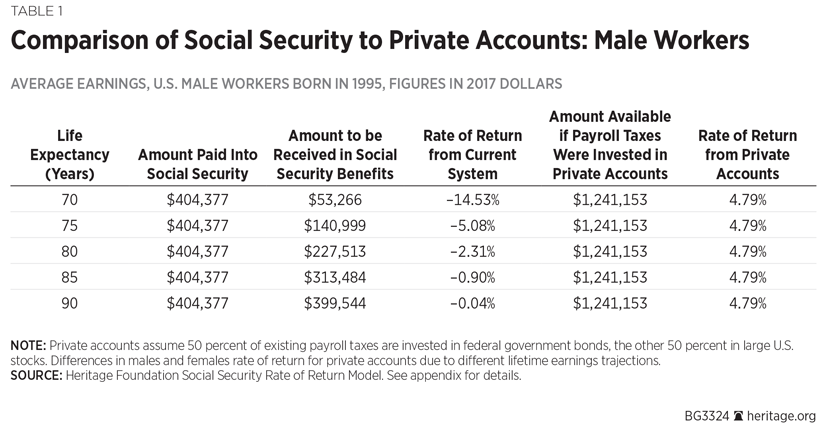
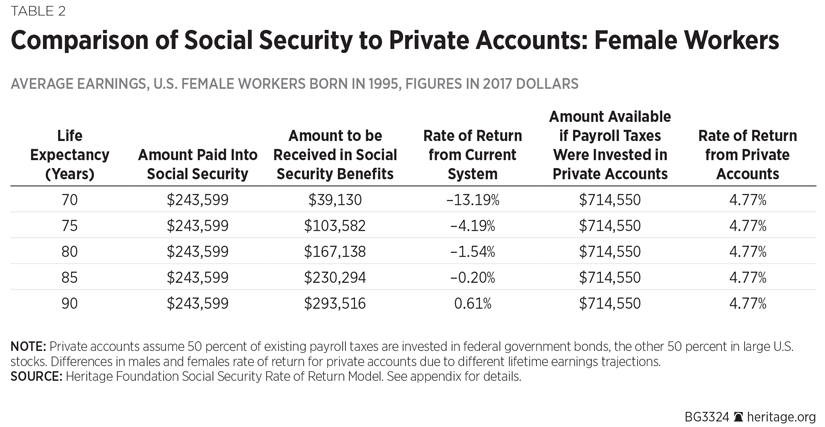
These results illustrate that Social Security provides extremely poor—often negative—rates of return for younger workers all across the country, especially for individuals with lower life expectancies. In comparison to the current system, private retirement accounts would provide significantly higher returns to Americans, regardless of their life expectancies.
State-by-State Analysis
We also used The Heritage Foundation Social Security Rate of Return Model to conduct a state-by-state analysis of the rate of return of Social Security versus a hypothetical simulation assuming payroll taxes used for Social Security were instead invested in private accounts. The following tables provide, by state of residence, the rate of return of Social Security compared to private accounts.
These tables, as well as the more detailed tables in our appendix, show workers’ estimated total lifetime Social Security benefits compared to their accumulated personal retirement account balances under two scenarios—tax increases or benefit cuts—that would make Social Security solvent over the long run. We also break total benefits and accumulated account balances down into monthly benefits and monthly annuities that workers could purchase using their personal retirement account balances. For both measures, we show workers by state, gender, and income level:
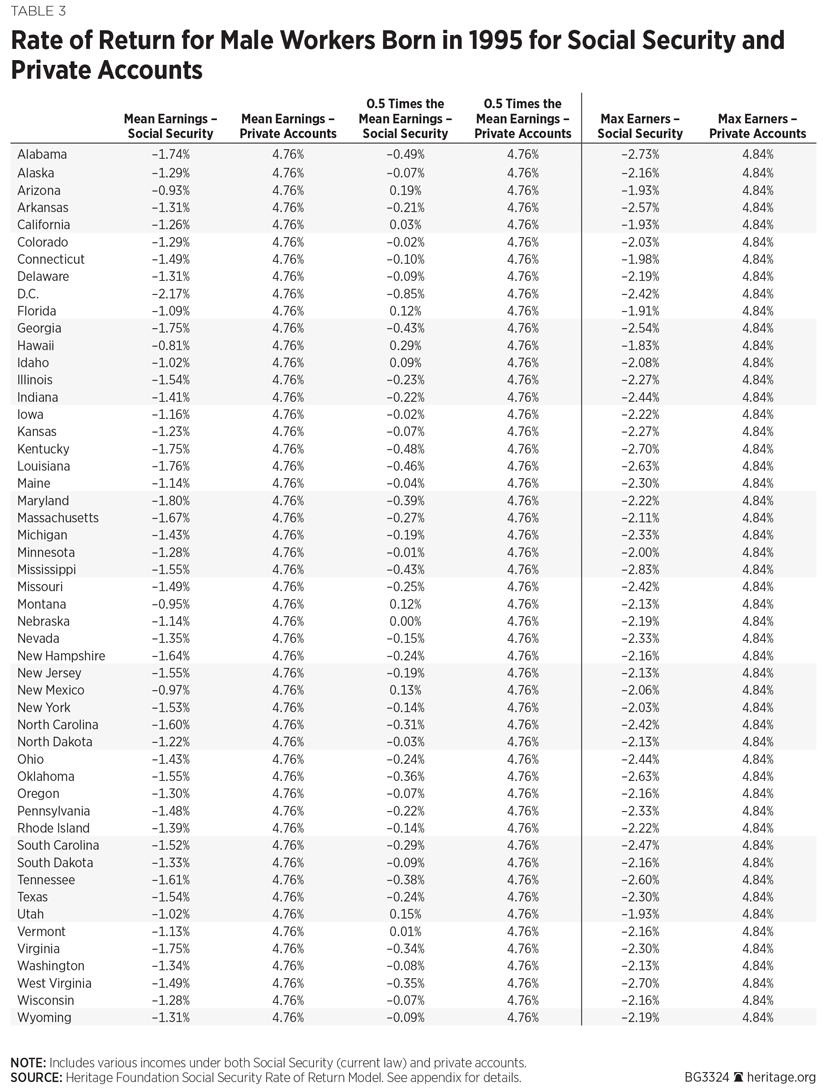
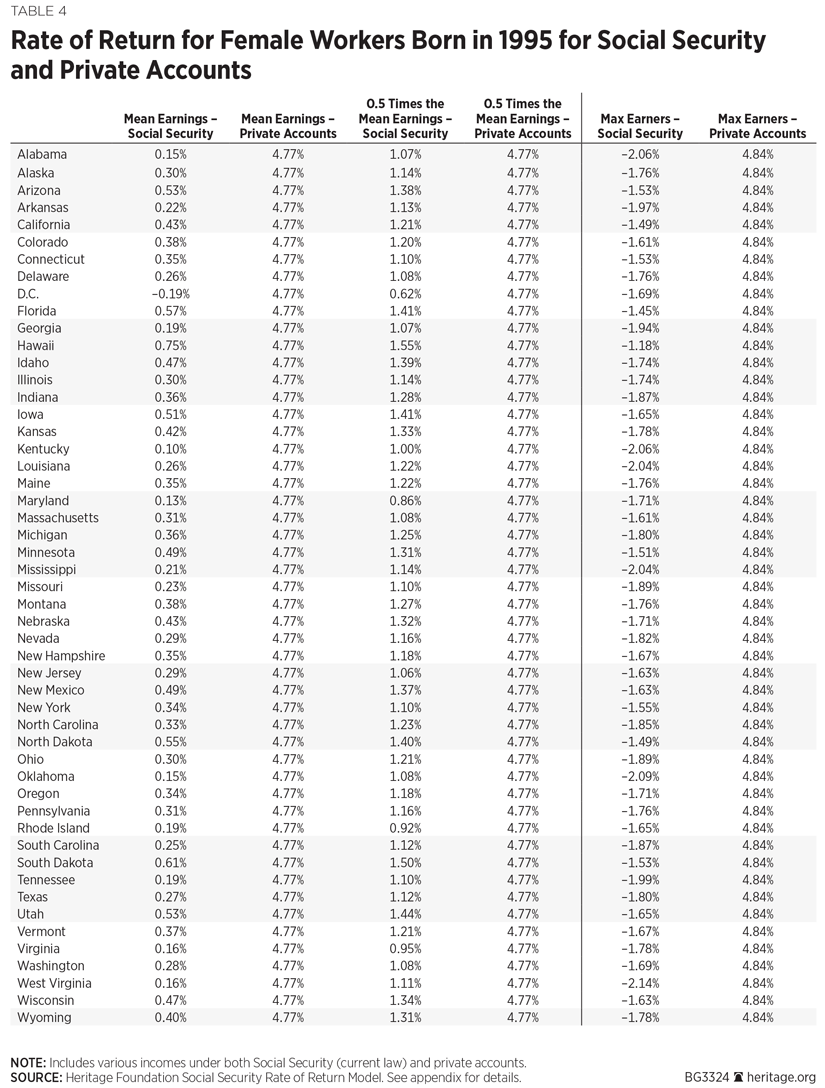
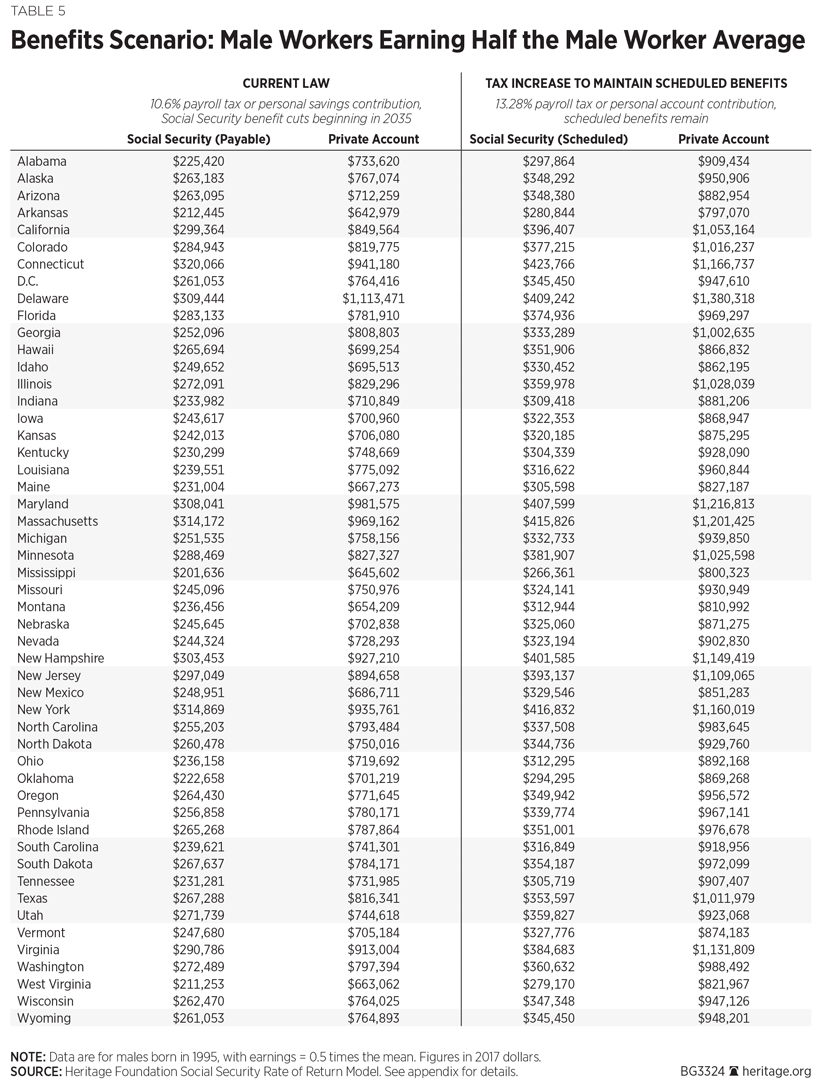
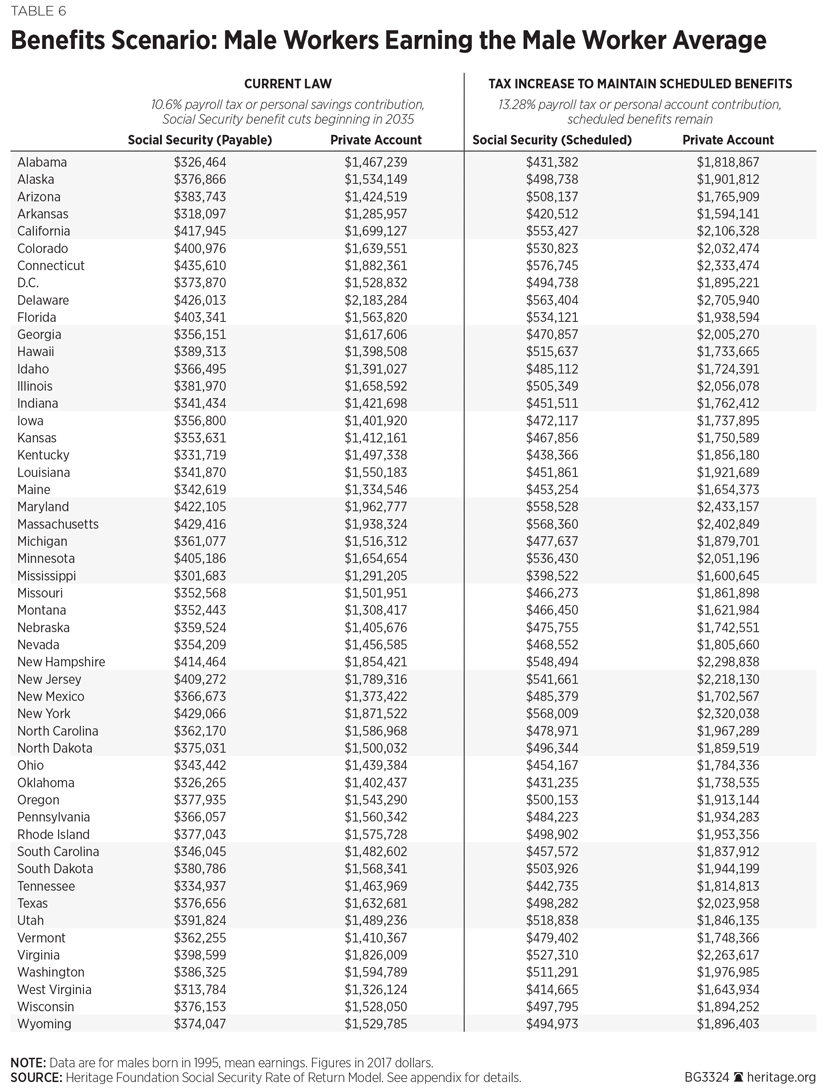
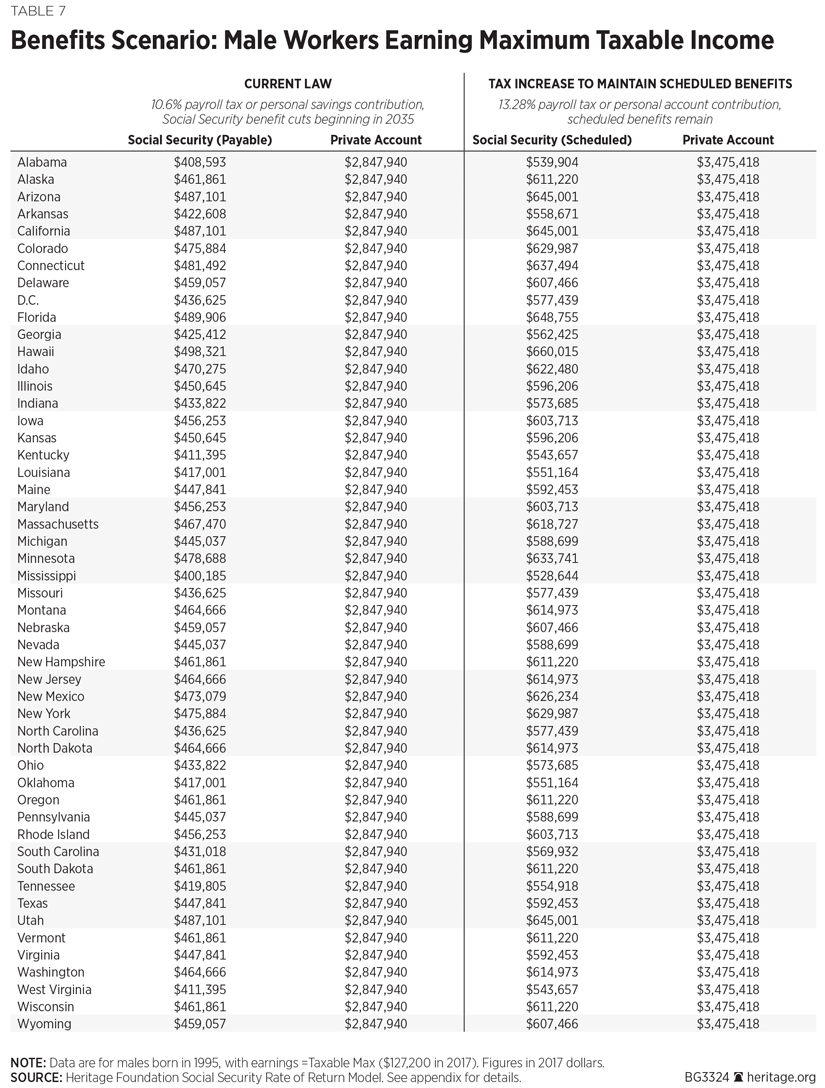
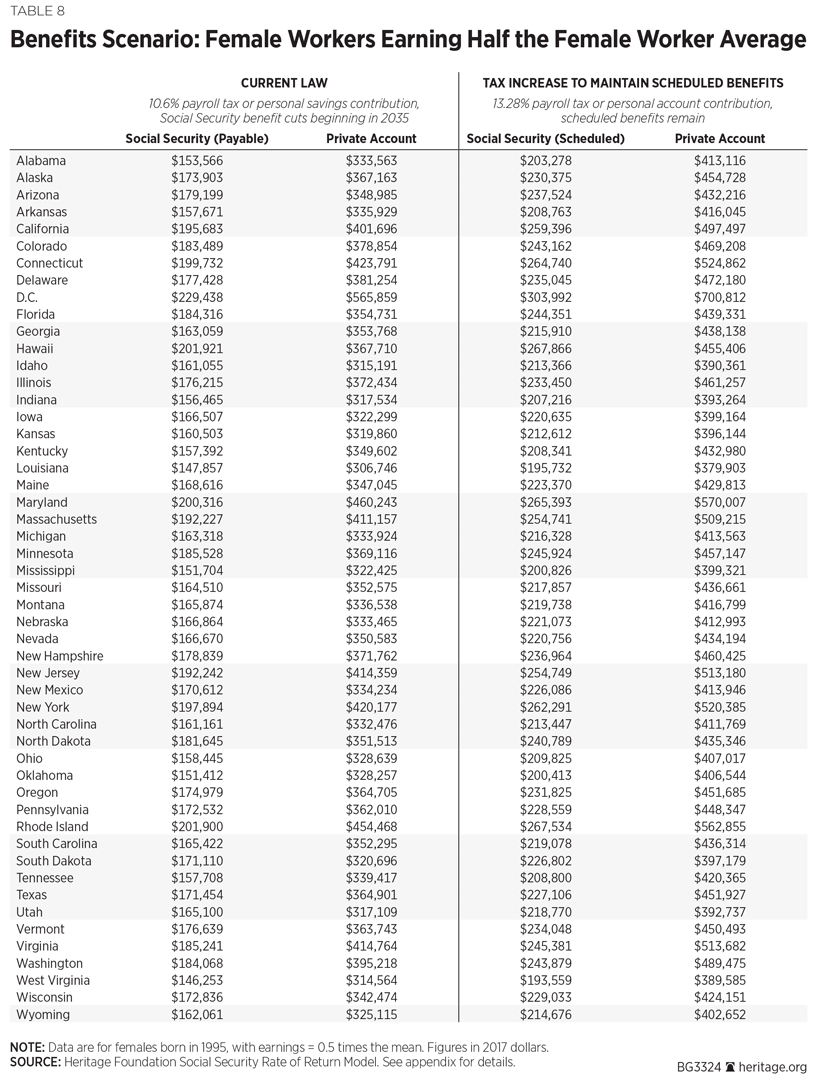
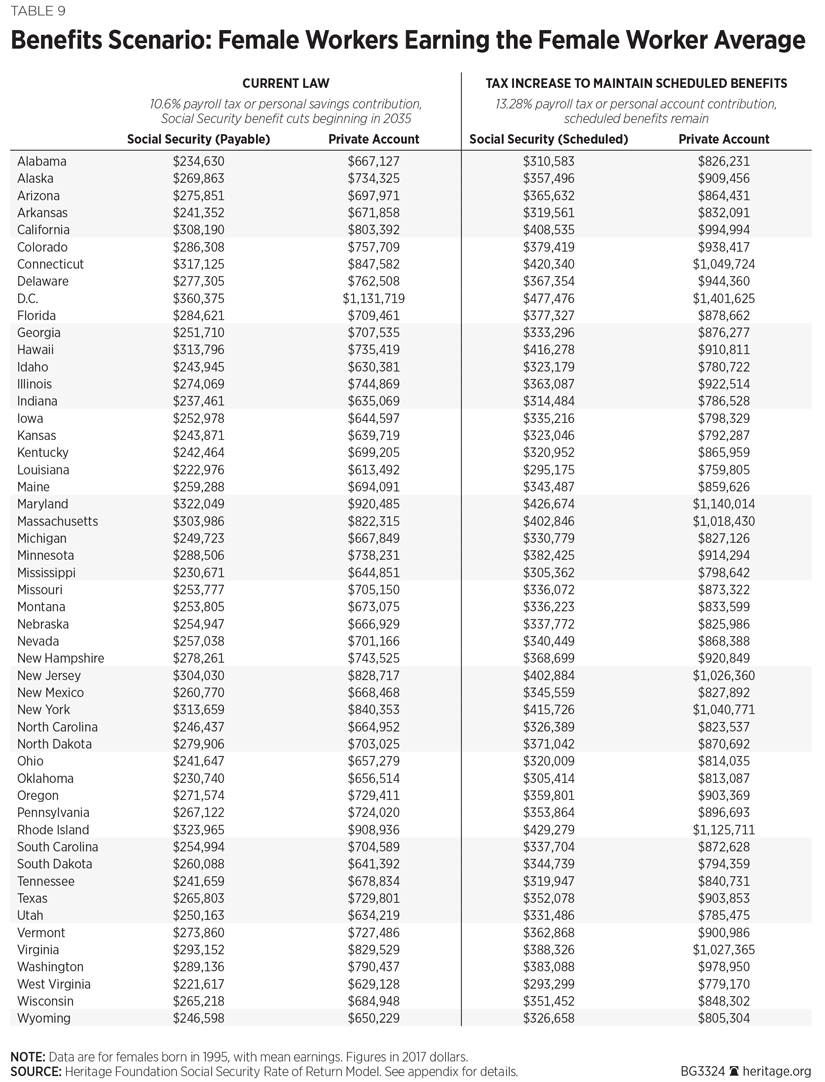
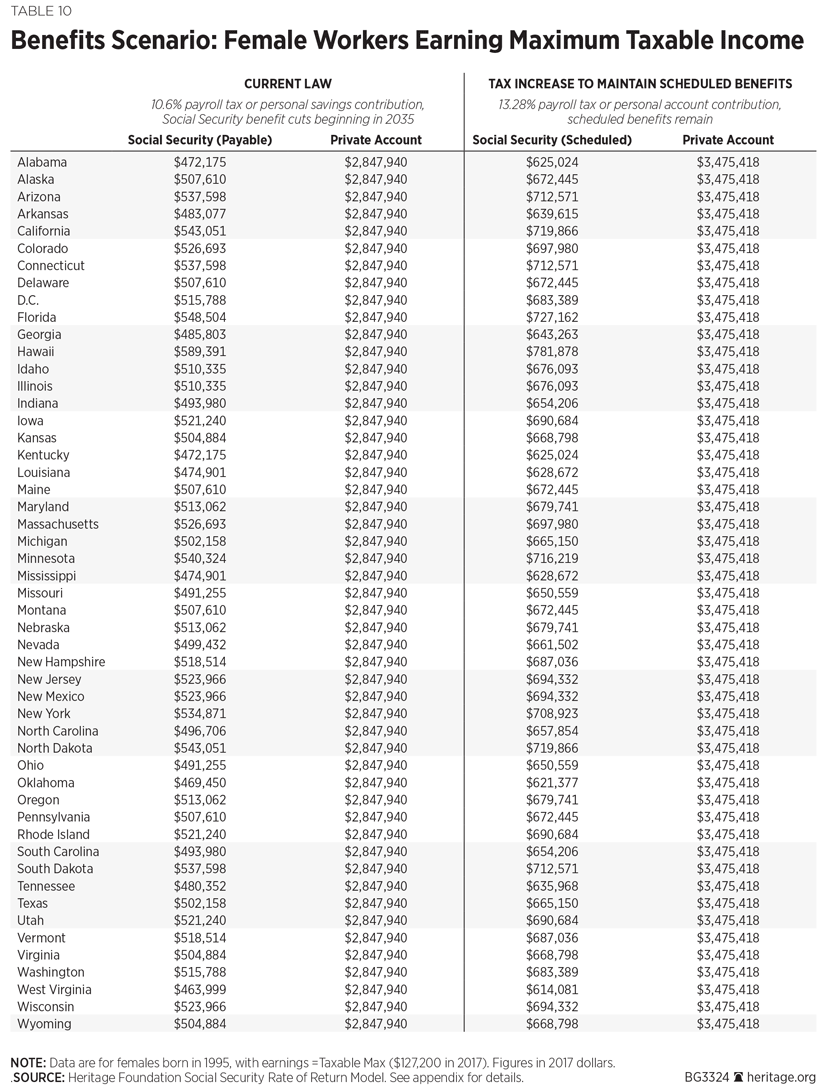
Our results demonstrate that younger workers (born in 1995) of all income levels would receive between two and seven times as much in retirement income from personal savings as they would from Social Security. Because Social Security paid out more in benefits than it collected in tax revenues to earlier generations, the gains would not be as large for older workers (those born in 1955 and 1975); however, they would still receive more from personal retirement accounts than from Social Security.
Why Private Savings Produce Higher Retirement Incomes than Social Security
Our results establish that personal investment accounts provide a significantly greater rate of return compared both to what Social Security can afford to pay as well as what it has promised to pay. Prior research comes to the same conclusion.20
Davis and Lacoude, What Social Security Will Pay. See, for example, Thomas A. Garrett and Russell M. Rhine, “Social Security Versus Private Retirement Accounts: A Historical Analysis,“ Federal Reserve Bank of St. Louis Review, Vol. 87 (March/April 2005), pp. 103–121, https://research.stlouisfed.org/publications/review/05/03/part1/GarrettRhine.pdf (accessed September 30, 2016), and Michael Tanner, “Still a Better Deal: Private Investment vs. Social Security,“ CATO Institute Policy Analysis No. 692, February 13, 2012, http://www.cato.org/publications/policy-analysis/still-better-deal-private-investment-vs-social-security (accessed October 4, 2016).
1. Higher Returns and Larger Retirement Incomes. Investment returns in the private market are two to three times the rate of return of U.S. Treasuries (what Social Security used to invest in when it ran surpluses). Consequently, even most low-income earners who get the most back from Social Security (relative to what they contribute) would end up with higher retirement incomes if they had personal investment accounts. This phenomenon was not always true in the past under Social Security’s unsustainable promises, but it is true for anyone in their 40s or younger today.
For example, a 23-year-old female, born in 1995, living in Florida and earning the average wage can expect a monthly Social Security check of $1,393 in 2017 dollars when she retires at age 67 in 2062. However, if her payroll taxes had been invested half in large-cap stocks and half in Treasury bonds, based on historical averages she could buy an inflation-adjusting annuity (similar to Social Security) that would provide $2,524 per month in year 2017 dollars.21
The single female earner in Florida would have $709,461 saved at retirement in 2017 dollars. If she purchased an annuity paying her a monthly payout until death, which adjusts for CPI-U each year, it would pay her an estimated $2,524 in monthly income in 2017 dollars. Rate is based on ImmediateAnnuities.com annuity quotes in effect October 21, 2016, https://www.immediateannuities.com/ (accessed May 5, 2017).
This amount represents almost twice the amount Social Security will be able to pay.
The same is true for other earners. A 23-year-old male, born in 1995, living in Florida and earning only half the average wage throughout his working years would accumulate enough in a personal account to receive an annuity that would pay $3,093 per month in 2017 dollars. Social Security can only provide him significantly less at $1,551 per month.22
The single male earner in Florida would have $781,910 saved up at retirement in 2017 dollars. If he purchased an annuity paying him a monthly payout until death, which adjusts for CPI-U each year, it would pay him an estimated $3,093 in monthly income in 2017 dollars. Rate is based on ImmediateAnnuities.com annuity quotes in effect October 21, 2016, https://www.immediateannuities.com/ (accessed May 5, 2017).
Even low-earning females (born in 1995) who tend to receive the most bang-for-the-buck from Social Security would receive 40 percent more from a personal account than from Social Security ($1,262 per month from a personal account vs. $902 from Social Security).
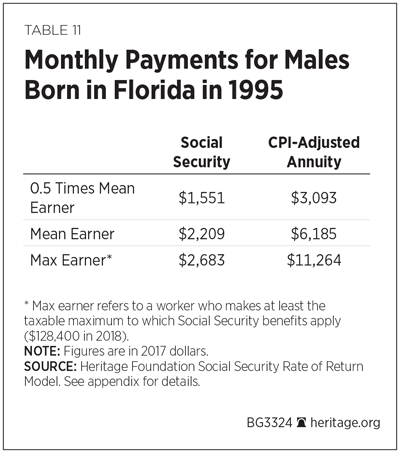
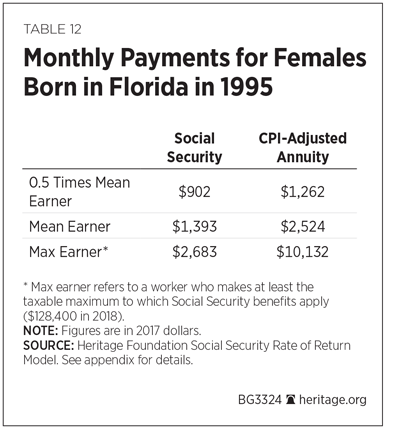
2. Continued Wealth Growth Post-Retirement. A second advantage of private retirement savings is that savings that are not withdrawn at retirement can continue to earn investment returns during retirement. Even with conservative investments, savings can continue to grow and provide for larger disbursements in subsequent years and bequests to help support family members, friends, or charities after death.
3. The Ability to Leave Bequests. Social Security prevents workers from passing on their “saved” payroll taxes to their heirs if they die before collecting benefits or shortly afterwards. Under the current system, a mean-income worker pays about $4,700 per year into Social Security’s retirement program.23
In the first quarter of 2017, the mean usual weekly earnings of full-time wage and salary workers was $855. This translates into $44,460 annually and would amount to $212,074 over a 45-year career, assuming the worker begins at age 22 and retires at age 67. Mean earnings come from U.S. Department of Labor, Bureau of Labor Statistics, “Table 1: Mean Usual Weekly Earnings of Full-Time Wage and Salary Workers by Sex, Quarterly Averages, Seasonally Adjusted,” https://www.bls.gov/news.release/wkyeng.t01.htm (accessed June 29, 2017).
Over a 45-year career, that is up to $212,000 that he could potentially lose if he dies before collecting benefits. Personal savings, on the other hand, do not disappear if their owners die before using them. Shifting some or all of Social Security’s taxes to personal savings could have a particularly large and positive impact on lower-income earners as well as on many other groups that tend to have lower life expectancies and are more likely to get little to nothing back from their Social Security taxes. Bequests can serve as more than windfall benefits; they can change individuals’ and families’ lifetime trajectories by providing money that can help a child or grandchild attend college, start a business, or make other investments in their futures.
4. Larger Paychecks, Greater Incomes, and Increased Wealth. Social Security could accomplish the goal of preventing poverty in old age with significantly lower taxes than it currently extracts. A smaller Social Security program would leave workers with bigger paychecks that they could use for current consumption, gaining education, pursuing business opportunities, building wealth, and generating higher retirement incomes. More income and wealth would make low- and middle-income communities more dynamic and prosperous places to live and work.
5. Increased Productivity. Personal savings that support private investments allow companies to create productivity-enhancing capital in the form of new machines, technology, and facilities. This increases the output of workers, which leads to better jobs and higher wages.24
For a discussion of what capital is and how it increases output, see Marginal Revolution University, “Physical Capital and Diminishing Returns,“ http://www.mruniversity.com/courses/principles-economics-macroeconomics/law-diminishing-returns-marginal-product-capital (accessed June 29, 2016). For a discussion of how workers’ income increases when the supply of capital increases, see James Sherk, “Labor’s Share of Income Little Changed Since 1948,“ Heritage Foundation Backgrounder No. 3111, May 31, 2016, http://www.heritage.org/research/reports/2016/05/labors-share-of-income-little-changed-since-1948.
The current Social Security system—which immediately spends all incoming revenues on retirees’ benefits—fails to accomplish the same productivity- and opportunity-enhancing effects.
Conclusion
This report provides workers with a comparison between what Social Security can provide and what they could receive if they had ownership of their Social Security payroll taxes. This information can help individuals of all ages understand what they can expect to get from the program in the long run.
The results are overwhelmingly clear. Americans would be better off keeping their payroll tax contributions and saving them in private retirement accounts than having to sacrifice them to the government’s broken Social Security system. Social Security’s design has, over the decades, presumed that many Americans are too incompetent to make informed decisions for themselves, but few Americans believe that the government knows better than they do what is best for them and their families. Moreover, Social Security’s financial structure effectively guarantees that workers will receive extremely low, or even negative, returns on their payroll taxes.
—Kevin Dayaratna, PhD, is Senior Statistician and Research Programmer in the Center for Data Analysis, of the Institute for Economic Freedom, at The Heritage Foundation. Rachel Greszler is Research Fellow in Economics, Budget, and Entitlements in the Thomas A. Roe Institute for Economic Policy Studies of the Institute for Economic Freedom. Patrick Tyrrell is Research Coordinator in the Center for International Trade and Economics of the Kathryn and Shelby Cullom Davis Institute for National Security and Foreign Policy, at The Heritage Foundation.




Rates of return – on a tax? So my rate of return on social security tax might be negative? I’m shocked. What’s the rate of return on my income taxes? Social security is welfare. It’s never been an “insurance policy” or a “retirement account”. Why did they even bother with their calculations? It’s like they just learned how to program Excel or bought their first business calculator. It’s a truism that rates of return on stocks exceed those of bonds.
If the dweebs at Heritage succeeded in privatizing Social Security would you really want the federal government running giant mutual funds among which people could divvy up their Social Security “contributions”? Can you imagine the corruption? And if people made bad choice and lost their money, we’d have to pay for them anyway because we couldn’t tolerate the sob stories of destitute oldsters who’d gambled and lost. Lastly, if Social Security tax money hadn’t been raided by the general fund, more borrowing would have been needed, and interest costs would have been higher for decades.
Social Security is an income transfer system. Period. I hope I get some money – I’d be happy to get a fraction of what I’d paid – but I have no illusion that it’s anything other than welfare for the middle classes.
It has always been nothing more than a wealth transfer program “disguised” as a retirement savings program. When will people finally learn? Of course the government couldn’t simply allow folks to save for themselves. How would that have created a dependent, subservient, government-supporting, voter class of senior citizens? How would that have provided trillions that have been wasted on everything from the Vietnam war to the war on drugs to the space program and so much more? Of course we would all have been better off with FREEDOM, but since the Progressives took over BOTH the republican and democratic parties in the early 1900s, FREEDOM has NOT been on the agenda for Americans.
The Social Security program is a scam, and has been since inception. For a few great decades, the scam held, and the people got dumber, and the confiscatory government grew. Now, the scam is falling apart due to simple accounting, the people are still getting dumber and the confiscatory government continues to grow without relent under Dems and Republicans alike.
I plan on having to work at something or other for wage until just before I die. Twenty or thirty years of idle retirement was a pretty good scam while it lasted, but it is just about over. Don’t lament the end of an injust system that never should have been started in the first place.
Don’t chortle, you people expecting public pensions; You are screwed too. You “millionaires” who saved and invested the “money” you earned? Screwed too.
This report does not reflect the real picture. It is based on manufactured statistics and false notions.
The majority of wage earners in this country cannot save money for retirement let alone purchase a home or a new car. Their wages are too low and have been falling behind the inflation rate for decades.
Yes the boomers are retiring in large numbers but they have contributed the most into the social security system. When the boomers are dead and buried the system will again come into balance.
The social security system has proved to be a good thing for many in retirement that did not save because they were unable to for many reasons.
When I was young and felt I was paying way to much into it. It was my thought that it wouldn’t be there for me to collect. But then my retirement age came and it was there. Just like it will be there for the next generation to collect.
The notion that most people will not save for retirement is based on flawed thinking. People with high incomes can save but these people are few compared to the general population. The working class cannot save for obvious reasons.
I am not a fan of Roosevelt but his insight about social security for the people was spot on. He knew the nature of the herd is not to save even in good times so he created an insurance plan for old age. Can you imagine the problems our society would be facing today if social security did not exist?
Social engineers of today don’t know human nature. They come up with all kinds of theories that don’t ring of reality; and like this writer, take statistics made up by think tanks compiling information, and using computer models that digest all this information, come up with outcomes that are far from reality.
The young people of this country are turning toward socialism because the free market has been denied them by the status quo.
The economic system created by the boomers is coming to an end because it has been captured by greedy men in our society that have directed the wealth to themselves. They have infiltrated government to work for them. Capitalism has turned ugly just like communism turned ugly.
The solution to this situation is in the past. As it is now the future holds no hope. Our current technologies have enslaved us to the status of economic slaves to the billionaires that run this country. Automation is turning us into automatons answering to computers that run the system. Every where we turn we hear how AI is taking over our human functions and even human will! What kind of world are we moving into? A world where human values no longer exist?
No wonder the young are turning to socialism. The herd is moving and restless. As time progresses it won’t be good for the 1%.
As for us boomers; Our time is coming to an end. All we have left in this world is influence. We pass the enchilada on to the next generation. Good luck.
That’s a great comment. Worthy of posting Jim, and see what people have to say about that
The young are “turning to socialism” because the alleged benefits are promoted without any discussion of the costs. As the libertarians say, “there’s no such thing as a free lunch”. Of course, there is such a thing as making someone else pay the bill.
What is your “fair share” of someone else’s lunch, comrade? Who decides and how is it enforced?
“Anyone who is 20 years old and not a socialist has no heart. Anyone who is 40 years old and still a socialist has no brain.”
I don’t care what FDR claims his intentions were. SS is not a fedgov power and should never have been created. FDR was a blueblood dickbag socialist crook hustler, anyway, and his plan was not to help people, but to make the fedgov powerful, steal as much for himself as he could, and push the US to the far left.
I believe FDR also knew he was buying millions of poor workers’ votes for the DNC in perpetuity same as LBJ knew he was buying blacks. I’ve seen a quote from FDR (couldn’t find it fast enough for here) that said, essentially, that he knew it would fail, but he knew it would fail long after he was already gone.
FDR was also an absolutely incompetent and buffoonish leader. If you read up on his random and unpredictable brand of leadership, it’s surprising to see the top US leaders, as well as Churchill and others all remarking on what an absurdly disorganized, clueless, and unreliable leader FDR was.
Thunderbird,
Much as I hate government “compulsion” there are a number of countries where private pension savings are mandatory. You have no access to savings until you retire. So just like SS, but instead of the money going to the government it goes to your own personal savings account. You have limited control over the investments as you can pick the type of investment fund etc.
It’s an uncomfortable fact that the members of the Greatest Generation who lived into their 80’s and 90’s were dead-weight, via the amount of Social Security they got paid, the same as Lashonda and her 5 bastard kids in the ghetto.
Iska is correct; SS has only been welfare until now. The older Boomers might break-even, but succeeding generations will see a big loss.
“5. Increased Productivity. Personal savings that support private investments allow companies to create productivity-enhancing capital in the form of new machines, technology, and facilities. This increases the output of workers, which leads to better jobs and higher wages.”
That is only true for new ventures or if existing companies raise new money by issuing more shares or borrowing on the bond market to expand operations or develop new products. Current markets are up in the stratosphere in large part by share repurchases, but they do nothing to boost employment or wages and in fact have the opposite effect. Buying existing shares on the market at high valuations do absolutely nothing except give executives and insiders an opportunity to cash out their stock options.
@ gilberts: my beef with FDR is he sold out millions of people at the Yalta accords. But his premise for the creation of SS is that millions would not or could not save for retirement. Today his insight has been proved to be right.
You are correct, sah. He and Churchill, both fucked over the East. Churchill wasn’t in much of a position to do much, anyway, but it burns me to think he basically sold out millions of people on a cocktail napkin. FDR, on the other hand, never met a Communist murderer he didn’t like. I hope he rots in hell.
Both public and private retirement “accounts” of all stripes are based on pure faith that this worldwide leveraged and terminally indebted fiat economic system is going to continue for all of the participating generations on both sides of payer/payee relationship.
I simply do not share that faith and am swayed by Warren Pollock’s contrarian view that it is time to jettison the trappings and get small:
[NOTE: Warren is a very prescient individual and it would be worth your time to study what he has to say and add it to the mix of current opinion: https://www.youtube.com/results?search_query=warren+pollock ]
Here’s what pisses me off about this whole Ponzi Scheme:
Since I started going To Sea in 1990, at the age of 24, between my employer and my contributions, SSI has collected the maximum from me, to the tune of $320k & change. I will turn 53 next week, which means there’s still another 14 1/2 “Working” years left before I’m “Eligible” to start receiving payments. At the rate that I “Contribute”, (and assuming they don’t raise the percentage any higher), I, (and my employer), will still “OWE” them roughly another $230k, at todays Earnings Cap, (which of course will continue to rise). If there were a way to opt out and walk away from what they’ve already taken, and just invest the rest of my “Working Years” myself, I’d do it in a heartbeat. Wanna bet that I could make better choices regarding “Investments” than The Gubmint?
But HERE’S what really galls me:
1) We KNOW that our “Estimated” Monthly Stipend will DEFINATELY be reduced by 2032.
2) They keep talking about removing the max cap on earnings, which would raise my annual “share” by yet ANOTHER $10k a year. and
3) The Douche Nozzles in DC will occasionally flap their lips about “Means Testing”, meaning that those of us who have been salting away on our own would wind up having been robbed for everything we’ve paid over the last 40+ years or so……..
They’re all Lying Liars who Lie, Rob, Cheat, and Steal…… Legally……..
Of course, let us not forget the Robert Reich’s, (and his ilk), who have suggested that IRA’s and 401k’s could, by the Sweep of the Gubmint Pen, be used to “Bolster” SSI back to Solvency….. Because “Fairness”……..
There is little doubt Social Security has become a bad deal for those forced to contribute . There is no doubt it has been poorly managed , poorly administered and the funds have been grossly misused or literally stolen . It is also a fact that the average American middle income wages have been plundered to a point where saving for oneself is nearly impossible add that to pathetic intrest rates on savings . Now bring in if you are invested in stocks you are competing against millisecond flash trades that engulf any gains you may have now add that to the devaluation of your currency saved and your screwed from all sides .
Now for tha 401K scam you average joe controls . You put up 100% of the funds accept 100% of the risk and losses while in the end recieve only 30% of any gains . Who dreamed this bull shit up you ask ?
The circle jerk that is Wall Street to K-Street to Capitol Street . The fix is in ! Also take note Paul Ryan wanted to raise retirement age to 70 for all us shmucks in fly over land as he announces he is taking his retirement from the federal government at age 48 wow nice gig for those grand public servants as many private pensions are tossed in the shitter as unsecured debt in bankruptcy . America circling the drain heading for shithole nation status !
Social Security is fine. There is no guarantee that large cap stocks return the next 30 years what they did over the last 30 years. In fact it is almost a guarantee that they won, at least in inflation adjusted terms (real inflation not the made up crap that doesnt count half the stuff). Disability of course should be completely separate of course.
Governments would have to make IRA contributions mandatory and at about the same rate (12.4% of income) as current social security levies but a strange thing would happen. Government revenue would plummet and when millions of people over 50 see that they have several hundred thousand dollars saved up ZIRP would not be popular at all. People like Bernanke and Yellen would be put in prison if they tried to steal billions from average citizens retirement accounts and woe to the politician who tried to inflate away government debt.
Nope, the last thing a government wants is a population of independently wealthy citizens who don’t need a monthly check from Uncle Sam.